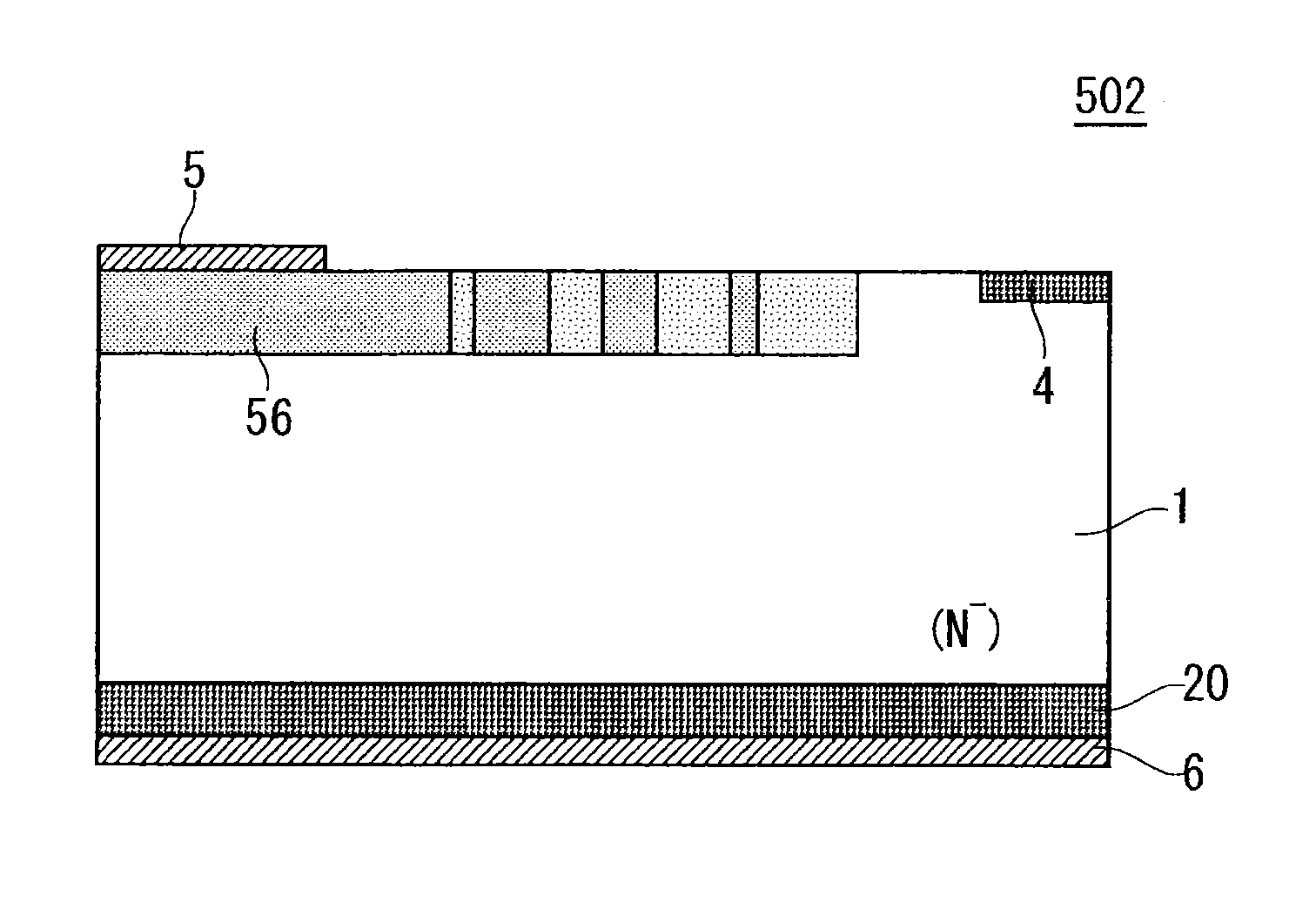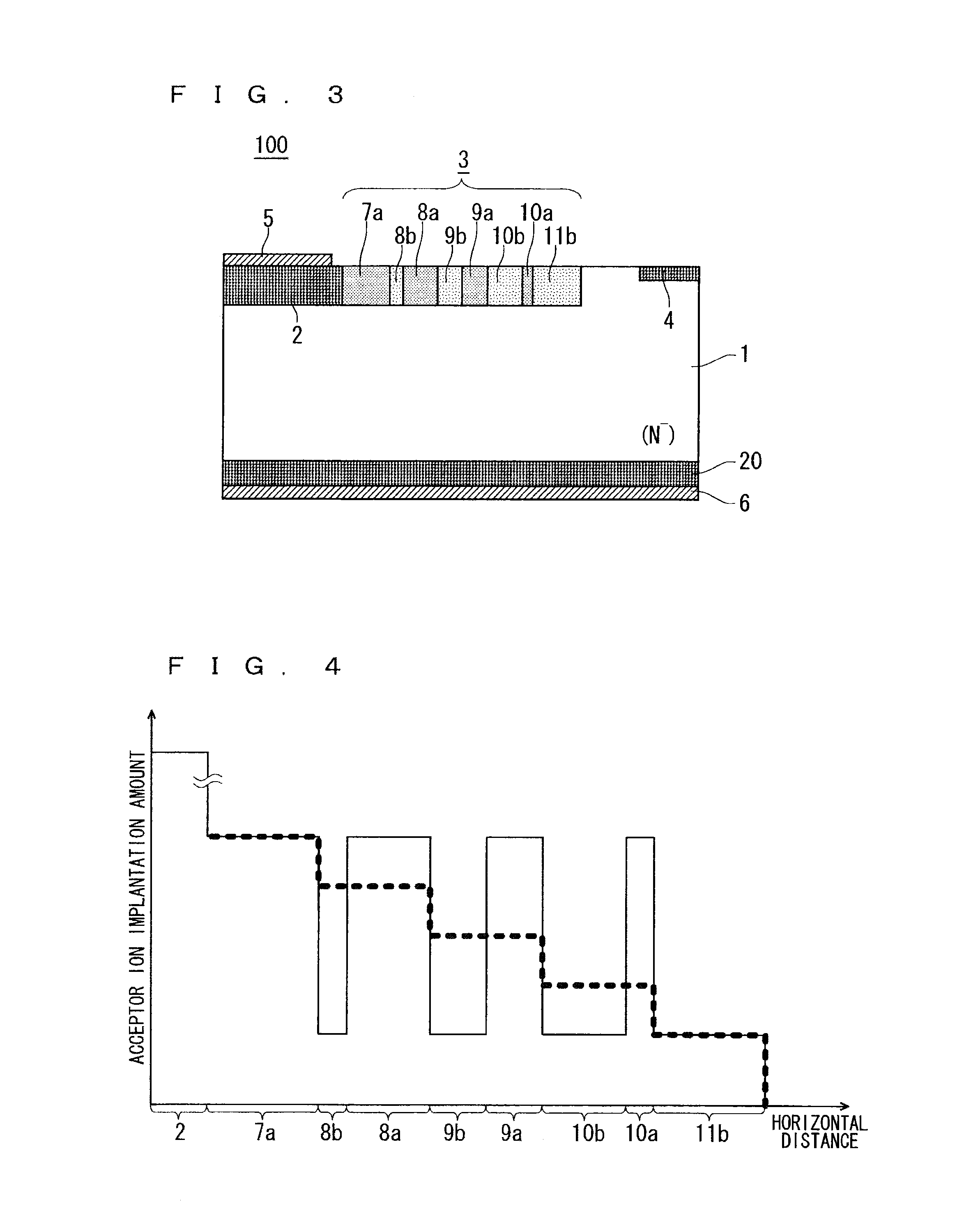Semiconductor device and method for manufacturing same
- Summary
- Abstract
- Description
- Claims
- Application Information
AI Technical Summary
Benefits of technology
Problems solved by technology
Method used
Image
Examples
first embodiment
A. First Embodiment
[0069]
[0070]FIG. 3 is a partial cross-sectional view of the vertical PIN diode 100 to which the present invention is applied, shown in FIG. 1.
[0071]As shown in FIG. 3, the active region (P-base layer) 2 containing a relatively high concentration of P-type impurities is formed in the surface of the semiconductor substrate 1 containing a relatively low concentration (N) of N-type impurities. The P-RESURF layer 3 (electric field relaxation layer) formed of a plurality of P-type implantation layers having different concentrations is formed to surround the P-base layer 2.
[0072]The stopper layer 4 containing a relatively high concentration of N-type impurities is formed at the device edge that is located apart from the P-RESURF layer 3.
[0073]The P-RESURF layer 3 is formed of two types of P-type implantation layers having different implantation amounts. For brevity, here, the two types of P-type implantation layers have a substantially identical implantation depth and ar...
second embodiment
B. Second Embodiment
[0134]
[0135]FIG. 15 is a partial cross-sectional view showing the configuration of an N-channel type MOSFET 200 to which the present invention is applied. The MOSFET 200 is an asymmetric lateral MOSFET and is referred to as a laterally doped MOSFET (LDMOSFET).
[0136]As shown in FIG. 15, the MOSFET 200 includes an N-type implantation layer (drain layer) 22 containing a relatively high concentration of N-type impurities that is provided in the front surface of one main surface of the semiconductor substrate 21 containing a relatively low concentration (P) of P-type impurities, a P-type implantation layer (P-well layer) 26 containing a relatively high concentration of P-type impurities provided in the surface of the semiconductor substrate 21 that is located apart from the drain layer 22, an N-type implantation layer (source layer) 27 containing a relatively high concentration of N-type impurities that is provided in the upper layer portion of the P-well layer 26, an...
third embodiment
C. Third Embodiment
[0161]In the lateral MOSFET according to the second embodiment of the present invention described above, all of the N-RESURF layers need to be formed of impurity layers having the same conductivity type for causing current to flow through the breakdown voltage structure. In the vertical diode as described in the first embodiment, however, the P-RESURF layer has a termination structure, and thus, all of the P-RESURF layers need not to be formed of impurity layers having the same conductivity type. Description will be given below of an example in which the RESURF layers are formed of impurity layers having different conductivity types.
[0162]
[0163]FIG. 20 is a partial cross-sectional view showing the configuration of a PIN diode 300 in a case where the present invention is applied to a vertical diode. The same references denote the same components as those of the PIN diode 100 shown in FIG. 3, and redundant description will not be given.
[0164]A RESURF layer 31 shown ...
PUM
 Login to View More
Login to View More Abstract
Description
Claims
Application Information
 Login to View More
Login to View More - Generate Ideas
- Intellectual Property
- Life Sciences
- Materials
- Tech Scout
- Unparalleled Data Quality
- Higher Quality Content
- 60% Fewer Hallucinations
Browse by: Latest US Patents, China's latest patents, Technical Efficacy Thesaurus, Application Domain, Technology Topic, Popular Technical Reports.
© 2025 PatSnap. All rights reserved.Legal|Privacy policy|Modern Slavery Act Transparency Statement|Sitemap|About US| Contact US: help@patsnap.com



